By Peter Hogness, Clarion Editor
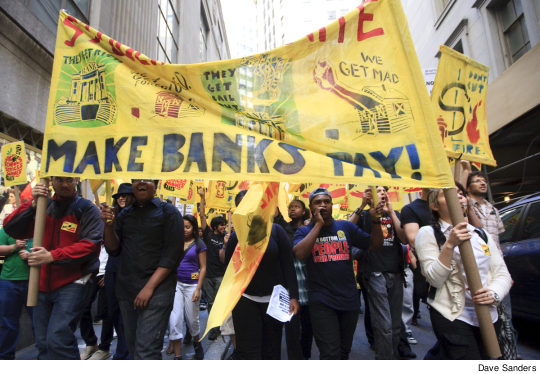 At the foot of Wall Street, the marching band played while a hundred people sang along: “We’re not gonna take it, we’re not gonna take it any more!” Behind the musicians, a banner called for banks and millionaires to pay more taxes; a sign on the trombone’s slide said “Stop the Cuts!”
At the foot of Wall Street, the marching band played while a hundred people sang along: “We’re not gonna take it, we’re not gonna take it any more!” Behind the musicians, a banner called for banks and millionaires to pay more taxes; a sign on the trombone’s slide said “Stop the Cuts!”
On May 12, thousands of people converged on the financial district in an energetic protest against the upside-down priorities in Mayor Bloomberg’s proposed budget, and the failure of the state and federal governments to make Wall Street pay for the economic crisis that it created.
“As a professor, as a citizen, I’m angry about this budget,” said Gerardo Renique, associate professor of history at City College. “It’s going to affect not only education but the future of this city, the future of our young people. It’s outrageous.”
 “There is plenty of money in this city, so we know money is not the issue,” said Elidio Jiménez, a Chief College Lab Technician at Lehman College. “Budget cuts definitely affect the kind of services the college can offer. They’re already affecting the adjunct budget. I’m in the science division, but you see it in the whole college.”
“There is plenty of money in this city, so we know money is not the issue,” said Elidio Jiménez, a Chief College Lab Technician at Lehman College. “Budget cuts definitely affect the kind of services the college can offer. They’re already affecting the adjunct budget. I’m in the science division, but you see it in the whole college.”
MESSAGE TO WALL STREET
 |
Shirley Frank, an adjunct assistant professor at York, said she has been directly affected by the cuts to date. “I’ve lost some of my classes – and it’s not from low enrollment, it’s from cutbacks,” she said. “It’s obvious that the money isn’t going where it’s needed. At CUNY, we have to scrounge around for a piece of chalk!”
Social needs are growing, said Frank, “but corporations are paying less and less. The money has been so unevenly distributed that you have to say we’re the victims of greed.” Frank was excited to see unions and community groups coming together to demand a change: “I think this is a wonderful demonstration, this is huge. We’re taking the message to Wall Street, and I love it!”
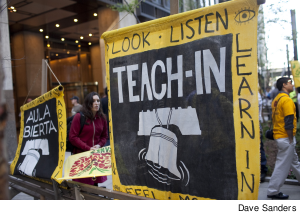 Gathering at eight different locations, from City Hall to the charging bull statue on Broadway, the crowds marched down the lower blocks of Wall Street and came together on Water Street. The protest included dozens of planned teach-ins on economic and budget issues, a large one at City Hall and many smaller ones arrayed along Water Street. The tumult of the crowd made it difficult for many of the teach-ins to occur as planned, but others went forward successfully in the midst of the music, drums and chanting, on topics from social service cuts to NYC’s housing squeeze to origins of the economic crisis. About one-third of the teachers for these session were PSC members.
Gathering at eight different locations, from City Hall to the charging bull statue on Broadway, the crowds marched down the lower blocks of Wall Street and came together on Water Street. The protest included dozens of planned teach-ins on economic and budget issues, a large one at City Hall and many smaller ones arrayed along Water Street. The tumult of the crowd made it difficult for many of the teach-ins to occur as planned, but others went forward successfully in the midst of the music, drums and chanting, on topics from social service cuts to NYC’s housing squeeze to origins of the economic crisis. About one-third of the teachers for these session were PSC members.
It was clear that the demonstration was big, but with eight different feeder marches it was hard to get a clear count. Journalists who ventured an estimate put the total at upwards of 10,000; organizers said that by the time the day ended with a march to Battery Park, 20,000 people had taken part. Regardless of the exact number, it was clear that thousands took part in a protest that was livelier than usual. The action was organized to be decentralized and mobile, avoiding being penned into a static location, and participants said this created an event that was both engaged and energetic.
BUILDING A MOVEMENT
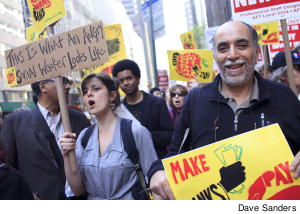 |
“It’s a great beginning,” said Joe Wilson, professor of political science at Brooklyn College. “I’m hoping we can foster a mass movement to challenge the policies of Wall Street, to fight for public education and the public interest. I think that movement will have to grow until the status quo is forced to respond.”
“It’s an exciting time, because it’s the first time I’ve seen students so organized and angry,” said Roopali Mukherjee, associate professor of media studies at Queens College. “I don’t think we can win without the students, and I wanted to support their efforts.”
“It’s wonderful to see so many students today,” agreed Wilson. “It looks like the United Nations out here! And that’s what we need. It’s going to take a united movement to overturn these bankrupt policies.”
Steve Garib, a student at Queensborough Community College, said he is worried about the effect of more budget cuts on both the cost and the quality of his education. “Tuition is supposed to go up,” he said, “and my family has some financial troubles. And the way QCC is now, I get extra help after class, like with math. That’s going to be out of there if they cut the budget. The computer labs will get hurt, too. QCC had to turn people away this semester. If there are less teachers next semester, it’s just going to be worse.”
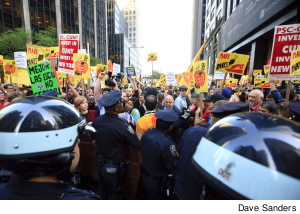 While CUNY’s budget is his first concern, Garib said, it’s not the only issue. “Honestly, I hope that all these people who came here for different reasons, like housing and immigration services and health care, I hope they get what they want also. Because it’s a shame that people have so much money but they don’t want to pay taxes. It’s not right that they get everything to go their way.”
While CUNY’s budget is his first concern, Garib said, it’s not the only issue. “Honestly, I hope that all these people who came here for different reasons, like housing and immigration services and health care, I hope they get what they want also. Because it’s a shame that people have so much money but they don’t want to pay taxes. It’s not right that they get everything to go their way.”
COMMUNITY AND LABOR
Community organizations also turned out in strength for the May 12 protest. “We are just appalled, we are furious, at what’s going on right now,” said Celina Lynch of Families United for Racial and Economic Equality (FUREE), a Brooklyn-based group organizing low-income families, mainly in communities of color. “The working class is not reaping the rewards like we should be. When you have a strong middle class, you have a strong economy – but the way the system is being run right now, it seems like it’s only catering to the big corporations. So we are here to support the working class and the middle class.”
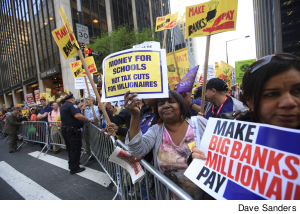 Kelitha Spence, a special education teacher at I.S. 125 in Queens, held a sign that said “Instruction, Not Destruction.”
Kelitha Spence, a special education teacher at I.S. 125 in Queens, held a sign that said “Instruction, Not Destruction.”
“Bloomberg is destroying our classrooms,” said Spence. “We already have 30 to 35 students in each classroom, for one teacher. That’s ridiculous. In schools in other countries they don’t go over 20 students. But rich people don’t care, because their kids don’t go to public school.”
With four years’ experience in the system, Spence said she is potentially vulnerable to the layoffs that Bloomberg has predicted. But she dismissed Bloomberg’s call to give the Department of Education the power to ignore seniority in layoffs. “I think he’s just trying to divide us,” said Spence. “Instead of taxing income above $200,000 a year, he wants to cut jobs of people who make $48,000 a year? That just doesn’t make any sense.”
Bloomberg and other wealthy New Yorkers are out of touch with what life is like for the majority, she added. “On CNN, I saw a banker complaining that $200,000 is ‘nearly poverty-level,’” said Spence, shaking her head. “Then what’s $48,000 a year, if $200,000 is ‘poverty-level’?”
DEMOCRACY
Another young protester wore a t-shirt that read, “Democracy Is Not A Spectator Sport” – and many in the demonstration said they were energized by the chance to make their voices heard.
“In my department, there’ve been two or three dozen courses cut this semester, and class sizes have gone up,” said Greg Vargo, an adjunct assistant professor in English at CCNY. “So I came today because I think the budget has to put the needs of ordinary people first. Also I came because I needed to see these streets transformed. The weight of capital in these streets is too strong, and I just wanted to be a part of people in the streets, to see that change.”
“I can’t wait for the next action,” said Ron Hayduk, a professor of political science at BMCC. “I think we should come back here on a regular basis. Let’s make Wall Street our Tahrir Square, let’s keep coming back.”

